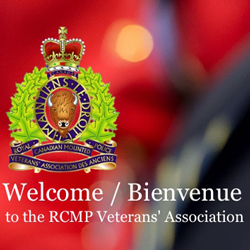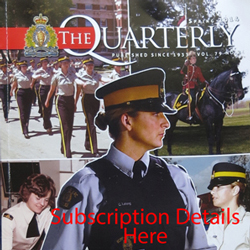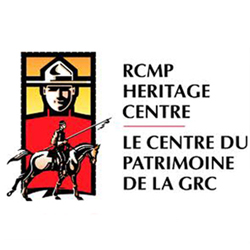Larry Burden’s This Day In The RCMP

The achievements and contributions of the Force have been built upon the individual contributions of many past Veterans. These contributions have largely been forgotten.
Veteran Sgt. Larry Burden (#35982), who served in “E” Division for 20 years, has spent many years researching and summarizing these achievements by specific date. Nearly every day, Larry sends out an email message with a selection from his work in progress manuscript “This Day In The RCMP” to individuals interested in these historical notes.
In an effort to share his research to a large group, Larry has agreed to permit us to develop a webpage on our website. Each webpage will post Larry’s historical notations over the past week.
If you wish to contact Larry Burden or provide additional information about his research, please email him at larryburden8@gmail.com.
April 13
1935 – In a special ceremony at Depot the new RCMP Guidon was presented to #O.240 Commissioner Sir James MacBrien by Max Aitken, Lord Bessborough. Present in the official party were #O.223 Supt Robert Tait, #O.189 Supt Cecil Hill and #8773 Sgt Joseph Leatham.
1973 – Commissioners Commendation awarded to #19780 Charles F. Martyn and #28861 E.R. McClare for a drug investigation at Toronto.
1997 – The Commissioners Commendation for outstanding service was awarded to #42298 Constable David Hardy of the Jasper Alberta Detachment.
When Cst. Hardy entered the detachment cells, he was jumped by a violent prisoner named Dean Welsh who overpowered him and proceeded to beat the constable with his own baton and handcuffs. Welsh then gouged at Hardy’s eyes, and pepper sprayed him, as he attempted to get his gun. Though he was suffering badly from the attack Constable Hardy managed to get hold onto his gun in the struggle and in effort to save his own life he had to fire eight rounds into the man before his attacker was finally killed.
April 12
1902 – An Order in Council granting compensation of 30 cents per day for life to #3513 Constable Seymour Farquharson because he lost his arm in a shotgun accident at Lake Labarge Yukon.
Constable Farquharson served from 1900 to 1902. He collected his pension until he died in 1964.
1908 – Honour Roll Number 32.
#4584 Constable George Ernest Willmett age 23 was murdered by a burglar, while on night patrol, in the town of Frank, Alberta.
Cst. Willmett had less than a year service when he was assigned to special night patrol in the Town of Frank due to a sharp increase in break and enters. While making his patrol he encountered two German immigrants; Mathias Jasbec and Fritz Eberts behind the Imperial Hotel. Without warning Eberts who had slipped into the shadows shot the plain clothes constable in the neck and face with a blast from his shotgun killing him instantly.
After an intensive three-year investigation, Erberts was fingered by his partner and he was subsequently convicted for murder. While in prison Erbert convinced death row inmate Sam Wilinsky to confess to the murder in hopes of being acquitted after Wilinsky was hanged.
Fortunately an alert guard found Erberts notes to Wilinski written on toilet paper thereby foiling his plan.
Cst. Willmet originally from Derby England was buried in the MacLeod Cemetery.
1917
The Battle of Vimy Ridge concludes.
The Battle of Vimy Ridge began at 5:30 a.m. on Easter Monday, April 9, 1917 and concluded on this day. The initial German advances of the war on the Western Front quickly turned into a stalemate of trench fighting, with the front line zigzagging for nearly 1,000 kilometres from the coast of Belgium to the border of Switzerland. Life in the trenches was unbearable with soldiers having to endure the cold, the death, mud, rats, lice and fleas.
The Battle of Vimy Ridge was the first time all four divisions of the Canadian Corps fought together as one formation. The planning and preparations for the battle were extensive and the Canadians spent the entire winter preparing for the battle by strengthening their lines, and training rigorously. They created models of the trench systems so the soldiers could be drilled on where they were and what they had to do and regularly raided German positions to gather intelligence on enemy defences. In addition they contracted tunnels beneath the Germans with train tracks, piped water, lights, and huge underground bunkers that were loaded with explosives for when the attack occurred.
During the week before the attack more than a million shells rained down during what the Germans called the “Week of Suffering.” Despite the success of the Canadian offensive it came at a heavy price for the 100,000 Canadians who served there, more than 10,600 casualties, nearly 3,600 of which were fatal.
Despite Commissioner A.B. Perry efforts to allow members of the force to enlist in the military in the early stages of WWI, the government would not let them serve, so members of the Royal Northwest Mounted Police had to take a voluntary discharge from the Force in order to enlist.
One of them was #3031 John Poyntz French, DSO of the Princess Patricia’s Canadian Light Infantry (PPCLI),the nephew of the second commissioner of the force, George Arthur French.
By the end of the war nearly 1,200 RNWMP members served in France and Belgium, and Siberia Of the 182 former RNWMP members interred in cemeteries in France and Belgium, 30 are named on the Vimy Memorial.
April 11
1911 – #4833 Constable William Wells was awarded $25 from the Fine Fund for his enforcement of the Public Works Act on the construction of the Grand Trunk Pacific Railroad. He served from 1909 to 1920 leaving the Force as a Sergeant.
1911 -#4822 Constable Henry Crane was awarded $50 from the Fine Fund for his actions in exhuming a body in ‘K’ Division. (Alberta) Crane served from 1909 to 1938 when he retired a Corporal.
1969 – Corporal #20673 C.G. (Chuck) Piper and Constable #23228 J.W. Faux are inducted into the Manitoba “Order of the Buffalo Hunt” for their actions in attempting to rescue a young boy from an ice flow on the Red River near Selkirk Manitoba.
April 10
1897 – O.96 Inspector Willam Scarth leading the 2nd contingent to Yukon, sailed from Victoria on “SS City of Topeka”. The contingent of men included #990 James Davis, #1959 Henry Donnelly, #1969 David McCulloch, #2256 William Conway, #2279 Peter Sabourin, #2286 James Good, #2299 George Bates, #2333 James Aspinall, #2589 William Saunders, #2793 Henry Dundas, #2839 Frederick Snell, #2914 Edward Smith, #3004 Wm Green, #3016 Cecil Carter, #3027 John Healy, #3035 Williamm Jealouse, #3056 Thomas Belcher, #3062 George Broster, #3068 James Stuart and #3118 Garnet Graham.
1963 – Parliament passes the Food and Drugs Act, getting more control over sale of drugs.
1965 – Honour Roll Number 130.
1965 – #20824 Constable Neil McArthur Bruce was shot after attending to a complaint involving a kidnap and rape of a young girl.
A newspaper boy passing a house in Powerview, near West Bank B.C. noticed a woman in the window signalling that she needed help. He called police and Constable Bruce and #23354 Constable Kenneth Jones attended the scene.
Believing that he could talk the suspect into surrendering and negotiate the girl’s release, Cst. Bruce removed his gun belt and walked out into the open to show that he was unarmed and was no threat to the suspect. What Cst. Bruce did not know that the suspect, Russell Spears was a cop hater with a long criminal history and in addition to being a notorious sexual deviant, and had bragged in prison that he would sooner shoot a policeman than be captured.
As Bruce walked towards the house, Spears promptly shot in the chest with a .22 caliber rifle. Russell Spears then fired off several more shots as his captive who had been raped several times and shot in the shoulder and jaw ran screaming from the house. Spears then burst out of the house and fled into the bush.
Cst. Jones then radioed for help and tended to both victims’ wounds until Cst. Bruce and the 16-year-old girl were transported to the hospital. Immediately after the shooting the RCMP began a massive manhunt for Spears that lasted ten days.
On April 12th doctors operated on Cst. Bruce and successfully removed the bullet from his right lung and it appeared that he would recover, but at 07:00 am on April 14th, he succumbed to pneumonia.
On April 20th a woman in the village of Trenpanier, ten miles south of Kelowna saw a suspicious man run across a field and she called the police. Shortly afterward the posse closed in and police dog handler #19758 Cst. George Hawkins and his dog “Prince” tracked Spears to a ravine. The dog flushed him out of the trees and instead of surrendering to the police; Russell Spears shot himself between the eyes with his rifle.
New Brunswick native Neil McArthur Bruce had been in the RCMP six years and was married with two small children.
2003 – A deranged man went into the Board of Works complex in Moncton N.B. armed with a loaded 12-gauge shotgun and threatened to shoot two supervisors.
While most of the employees fled to safety, James Garrity stayed behind and confronted the gunman in the engine repair shop. As Mr. Garrity attempted to calm the man, constables #40921 J.J.F. LeBrun, #46419 Alain Boulianne and #47988 John Bernard arrived and assumed tactical positions nearby. When the gunman was momentarily distracted the trio of officers rushed the suspect and assisted by James Garrity who had grabbed the shotgun, succeeded in subduing him.
In recognition of his heroism James Garrity was awarded the Commissioner’s Commendation.
2023 Honour Roll 249
#65876 Constable Harvinder Singh Dhami age 32 had been in the RCMP for four years when he died in the line of duty as a result of a motor vehicle collision.
“Harvey” as he was affectionately known to his co-workers was responding to a colleague’s urgent request for assistance at a noise complaint about 2 a.m. on Township Road 540, near the northeast edge of Edmonton in Strathcona County, Alberta when he lost control of the vehicle he was driving and collided with a concrete barrier. Several RCMP officers and members of the public rushed to his aid; however, he, unfortunately, succumbed to his injuries on the scene.
Dhami was survived by his wife Dhami-Randhawa. His older brother Gurvinder Dhami, was a constable with Peel Regional Police in Ontario.
Constable Harvinder Singh Dhami is the first RCMP member of the Sikh faith to have died in the line of duty.
April 9
1874 – Members of Parliament voted to expel Louis Riel from sitting as a Member of Parliament.
1986 – Four Medals of Bravery were earned by Sergeant #21869 William G.C. Andrews, and Constables, #31933 Jan Van Den Born, #33984 Reginald Charles Steward and #37510 Randall William Marquardt.
While patrolling the streets of Coquitlam, BC, Cst. Marquardt saw smoke coming from the 9th floor of a 12 story high-rise apartment building. He called for backup and notified the fire department before entering the building. He rushed up the stairs to the 12th floor and began knocking on doors to warn occupants and direct them to the stairwell.
As he banged on doors working his way to the lower floors alerting occupants, the dense smoke spread throughout the building. Due to the intense smoke on the 9th floor he could not enter the and then proceeded to the 8th floor where he was met by Sgt. Andrews who helped him banging on doors.
On the 6th floor, they were joined by Cst. Reg Steward who had obtained a master key, so the trio went back to the 12th floor to ensure all occupants had left the building.
Still unable to enter the 9th floor, the men left the building and helped Cst. Marquardt, to an ambulance for treatment of smoke inhalation. Cst. Steward and Sgt. Andrews then began assisting in crowd control and then saw seven people still stranded on 9th floor balconies. The pair accompanied by Cst. Jan Van Den Born re-entered the building, climbed to the 9th and forced their way into the apartment and broke the balcony windows to get to the occupants. The three police officers then guided them to the stairwell and down the stairs where they were treated for smoke inhalation.
On September 25th 1987 the four men were presented with Medals of Bravery by the Governor General of Canada.
April 8
1931 – Constable #10732 Joseph Sixsmith is sent to Big River, Saskatchewan to open a new Detachment.
Located north of Prince Albert, Big River was the departure point to the far north, and the graded dirt road leading to it ended fifteen miles south of town thereby leaving the traveler a choice of a number of winding trails leading out of the bush. The new detachment office was also the constable’s house, a medium size bungalow with no electricity or water and a wood stove for both heat and cooking. The office phone was listed in the directory as number nine, that being the total number of phones in Big River at the time. In addition to policing the village by himself Constable Sixsmith was also responsible for policing a large rural area covering the Big River Indian Reserve, Shell River, Debden, Stump Lake, Park Valley, and as far north as Dore Lake. Paroling these areas in the 1930’s often meant getting the police car hung up on a stump or stranded in a mud hole. Sixsmith served from 1929 to 1957 and retired as a Staff Sergeant.
1942 – The Kings Police Medal for gallantry was awarded to #11979 Lionel Fred Muirhead Strong, for his bravery on this day in rescuing a nine year old boy from a crumbling cake of ice in the Hillsborough Bay harbour, in PEI.
After a report that a young boy was adrift on an ice flow was received, several members of the RCMP and the Charlottetown City Police rushed to the scene, but no boat was available. When the ice flow the child was on broke in two and he fell into the frigid water, Constable Strong stripped off his hat and tunic and wearing his high brown boots and breeches dove into the frigid water and swam two hundred yards to the child’s aid. When he reached the boy he was clinging to a broken piece of ice with only his head above the surface. Grabbing hold of the child he towed him back to shore.
Prior to the implementation of a Canadian bravery awards system in 1972, the King’s Police and Fire medal which was instituted in 1909 and was the highest civilian award for bravery for police officers in the British Empire.
Constable Strong joined the RCMP in 1933 and retired as a Sergeant in 1958.
1942 – Many fund raising activities took place across Canada by a variety of organizations during WWII, and the police were no different. Through the efforts of Windsor Ontario policeman James Wilkinson and the Police Association of Ontario $25,000 was collected to purchase a Spitfire MK fighter plane for the Royal Canadian Air Force.
On this day in 1942 the first plane named “Canadian Policeman” BL900 was formally presented to the RCAF in North Weald England and assigned to the 403 Squadron. Present at the dedication ceremony were RCMP Provost Corps members #11507 Major George Ball, #12609 Captain James Stewart, #11747 Lieutenant Charles Wilson, #11965 Lieutenant Maurice Byers and #12604 Lieutenant Henry Law.
The pilot chosen to fly her into combat was #12568 Pilot Officer Constable Gordon Francis C. “Ben” Hoben, who had served as a Wellington bomber pilot in Italy and Germany.
Unfortunately the spitfire was destroyed on May 4th 1942 during a taxiing accident.
The nameplate was transferred to another plane but sadly Hoben was killed and the “Canadian Policeman” was destroyed when on July 11th 1942 Hoben decided to show off in front of his former Bomber Squadron (102) buddies and do some hot-dogging over top of the Topcliffe Aerodrome. After flying between two hangars below the rooftops, Hoben rolled his Spitfire and lost control of the aircraft and crashed.
Over the decades a number of stories about the “Canadian Policeman” appeared in a variety of publications (including the RCMP) that told the tale that the Spitfire was badly shot up in combat and that Pilot Officer Hoben heroically managed to land his plane near but died soon after. The propaganda that was created to portray Hoben as a hero was deemed necessary so as to deceive the enemy and the Canadian public because the Air Force still needed recruits.
The five-year veteran of the RCMP was buried in England. Hoban joined the RCMP June 22, 1935 and served in “D”, “F” and “O” Divisions.
1950 – The RCMP Schooner “St. Roch” leaves Esquimalt Harbour and journeys to Halifax through the Panama Canal. Commanded by Inspector #11814 / O.372 Kenneth William Newman Hall arrived in Halifax on May 29, 1950 becoming the first vessel ever to circumnavigate North America.
1978 – Commanding Officers Commendations were awarded to Constables #31682 Dana B. Gibbons and #34152 M.K. Stewart along with civilians Mr. N.G. McPherson and Darren Page for saving the life of a man by rescuing him from a burning house at Churchill, Manitoba.
April 7
1877 – The saying that the Mounties “always get their man” is usually considered to be the creation of Hollywood. But, surprisingly, the phrase can be traced to 1877, many years before the film industry.
In 1877, the Fort Benton (Montana) Record reported the following story from Fort Macleod:
“Thanks to the vigilance of Major Irvine (#O.30 Inspector and future Commissioner Acheson Gosford Irvine) and the energy of Captain Winder (#O.5 Sub Inspector William Winder), of the N.W. Mounted Police, another attempt to smuggle whiskey has been frustrated by the arrest of three men, who were tried, found guilty and sentenced to pay a fine of five hundred dollars each or be imprisoned for the minor period of six months. They preferred the former. Horses were sacrificed for the arrest, but the M.P. ‘s are worse than bloodhounds when they scent the track of a smuggler, and they fetch their men every time.”
1964 – Commendation awarded to #16590/ O.584 Jack Denison Routledge D.F.C. for his bravery in apprehending a man who had threatened to kill a member of the Force. He served from 1950 to 1979 and 2003 after having retired as a Chief Superintendent he authored a book about his life entitled “Lancaster’s & Lanyards“.
In which he described his adventures in the Royal Canadian Air Force in WW2 where he joined Bomber Command as a rear gunner at the age of 16 and flew in over thirty bombing raids and earned the Distinguished Flying Cross as well as his adventures in the British Columbia Police Force and the RCMP.
1980 – Commanding Officers Commendations were issued to #30078 Christopher Fernandes and #34583 R.L. Eldridge for apprehending a mentally unstable man with a handgun. Constable Fernandes served for several years as a member of the “E” Division (British Columbia) Underwater Recovery Team and became the first police diver in Canada to contract Aseptic Bone Necrosis and had to get a hip replacement. This did not end his career. The black belt in karate received a new hip in 199? And returned to active duty.
April 6
1935 – Commendation issued to #12041 Constable Henry Maxted for locating a missing person in a blizzard. Maxted served from 1933 to1970 retiring as an Assistant Commissioner.
1942 – WWII, 11th reinforcement draft to the Provost Corps included #10170 Cortlandt MacDonell, #13283 Ernest Shortt, #13467 Lorne Fennell and #13542 Albert Sewell.
1967 – Former Commissioner of the RCMP #11757 / O.314 George Brinton McClellan, CM, OBE, DFC. O. of Ontario. is appointed ombudsman of Alberta, becoming the first ombudsman in Canada.
1971 – The first new plane purchased by the RCMP after WW2; a Beechcraft D18- “CF-MPH” was officially turned over to the RCMP museum and was placed on a pedestal outside of the museum at Depot. This historic aircraft was in service for 24 years and flown by 45 different Force pilots. Flown all over Canada and the United States the plane logged over 11,286 hours and flew in excess of 2,000,000 miles.
1977 – Honour Roll Number 152.
#25308 Constable Dennis Modest Nicklos Shwaykowski age 31 was killed when he was thrown off a moving truck, while attempting to apprehend the driver.
The Red Deer Alberta detachment received a call reporting there had been a “looney” at a local pub with a shotgun and that he was now driving around the mall in his pickup truck. The suspect, Stan Hicks and his girlfriend had broken up earlier and the jealous Hicks had spotted her that evening at the pub and had gone home for some weapons.
Constables Shwaykowski and #27461 Dave Guy were working in the area in plain clothes and responded to the call. As they proceeded to the pub they spotted Hicks in his truck and Constable Shwaykowski ordered Hicks to get out of his vehicle. When Hicks ignored the policemen’s orders to get out of the vehicle and began to drive away Constable Shwaykowski made the mistake of jumping on the running board of the moving truck and attempted to arrest Hicks by grabbing his shirt. As the men struggled Hicks accelerated to a speed of about 50 miles (80 kilometers) per hour and drove toward a landscaped area of rocks and shrubbery.
When the truck struck the curb, Constable Shwaykowski lost his balance and was thrown from the running board, and struck his head on some boulders and was killed instantly.
Stanley Hicks pleaded guilty to criminal negligence causing death and was sentenced to three years in prison. Dennis Shwaykowski was buried at the Birchwood Cemetery in Swan River Manitoba.


 April 16, 2025
April 16, 2025 






